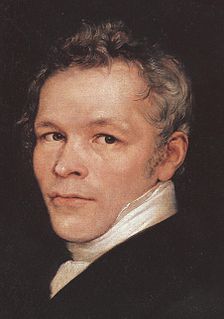
SK Austria Kärnten was an Austrian association football club, from Klagenfurt, Carinthia.

The Altes Museum is a museum building on Museum Island in Berlin, Germany. Since restoration work in 2010–11, it houses the Antikensammlung of the Berlin State Museums. The museum building was built between 1823 and 1830 by the architect Karl Friedrich Schinkel in the neoclassical style to house the Prussian royal family's art collection. The historic, protected building counts among the most distinguished in neoclassicism and is a high point of Schinkel's career. Until 1845, it was called the Königliches Museum. Along with the other museums and historic buildings on Museum Island, the Altes Museum was designated a UNESCO World Heritage Site in 1999.

The Neue Wache is a building in Berlin, the capital of Germany. It serves as the "Central Memorial of the Federal Republic of Germany for the Victims of War and Dictatorship". It is located on the north side of the Unter den Linden boulevard in the central Mitte district. Dating from 1816, the Neue Wache was designed by the architects Karl Friedrich Schinkel and Salomo Sachs. It is a leading example of German Greek Revival architecture. Originally built as a guardhouse for the troops of the crown prince of Prussia, the building has been used as a war memorial since 1931.
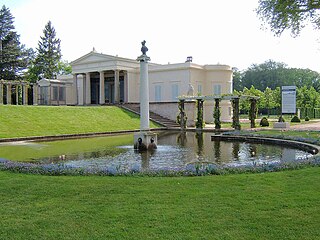
Charlottenhof Palace or Charlottenhof Manor is a former royal palace located southwest of Sanssouci Palace in Sanssouci Park at Potsdam, Germany. It is best known as the summer residence of Crown Prince Frederick William. Today it is maintained by the Prussian Palaces and Gardens Foundation Berlin-Brandenburg.

Glienicke Palace is a historic palace located on the peninsula of Berlin-Wannsee in Germany. It was designed by Karl Friedrich Schinkel around 1825 for Prince Carl of Prussia.

The Bauakademie in Berlin, Germany, was a higher education school for art of building to train master builders. It originated from the construction department of the Academy of Fine Arts and Mechanical Sciences, which emphasized the aesthetic elements of art of building while ignoring the technical. Thus, the governmental Upper Building Department ("UBD") decided to establish an entirely new building educational institution named "Bauakademie". It was founded on 18 March 1799 by King Frederick William III and, in 1801, incorporated into the UBD, as its section.

Kenneth Calvin "Whitey" Schinkel is a retired professional ice hockey right wing and coach. He played for the New York Rangers and Pittsburgh Penguins in the National Hockey League.

Friedrichswerder Church was the first Neo-Gothic church built in Berlin, Germany. It was designed by an architect better known for his Neoclassical architecture, Karl Friedrich Schinkel, and was built under his direction, 1824-1831.

Schinkel is a municipality in the district of Rendsburg-Eckernförde, in Schleswig-Holstein, Germany.

Krummwisch is a municipality in the district of Rendsburg-Eckernförde, in Schleswig-Holstein, Germany.
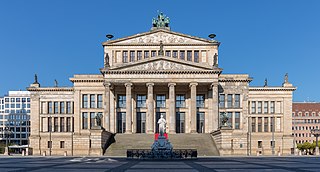
The Konzerthaus Berlin is a concert hall situated on the Gendarmenmarkt square in the central Mitte district of Berlin housing the German orchestra Konzerthausorchester Berlin. Built as a theatre from 1818 to 1821 under the name of the Schauspielhaus Berlin, later also known as the Theater am Gendarmenmarkt and Komödie, its usage changed to a concert hall after the Second World War and its name changed to its present one in 1994.

Frank "Frenkie" Schinkels is a former professional football midfielder and Austrian international team player and current coach.

The Moross House is a house located at 1460 East Jefferson Avenue in Detroit, Michigan. It is one of the oldest surviving brick house in the city; it was designated a Michigan State Historic Site in 1971 and listed on the National Register of Historic Places in 1972.

The Prussian National Monument for the Liberation Wars is a war memorial in Berlin, Germany, dedicated in 1821. Built by the Prussian king during the sectionalism before the Unification of Germany it is the principal German monument to the Prussian soldiers and other citizens who died in or else dedicated their health and wealth for the Liberation Wars (Befreiungskriege) fought at the end of the Wars of the Sixth and in that of the Seventh Coalition against France in the course of the Napoleonic Wars. Frederick William III of Prussia initiated its construction and commissioned the Prussian Karl Friedrich Schinkel who made it an important piece of art in cast iron, his last piece of Romantic Neo-Gothic architecture and an expression of the post-Napoleonic poverty and material sobriety in the liberated countries.
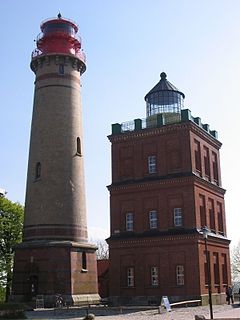
The Cape Arkona Lighthouse comprises two lighthouses and a radio navigation tower on the German Baltic Sea coast in Mecklenburg-Vorpommern, with the international serial number C 1062. It is located on Cape Arkona on the peninsula of Wittow on the northern tip of the island of Rügen.
Schinkel is a district of Osnabrück, Germany, first mentioned in records in 1332. It is situated in the east of the city, into which it was incorporated on 1 April 1914. There are roughly 13,300 people in Schinkel.

Schlossbrücke is a bridge in the central Mitte district of Berlin, Germany. Built between 1821 and 1824 according to plans designed by Karl Friedrich Schinkel, it was named after the nearby City Palace (Stadtschloss). The bridge marks the eastern end of the Unter den Linden boulevard.
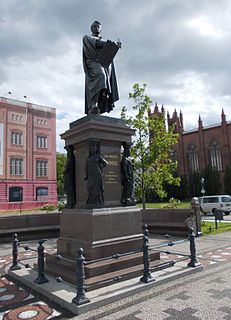
The statue of Karl Friedrich Schinkel is a bronze sculpture installed at Schinkelplatz in Berlin, Germany.
This page is based on this
Wikipedia article Text is available under the
CC BY-SA 4.0 license; additional terms may apply.
Images, videos and audio are available under their respective licenses.

